Related Research Articles
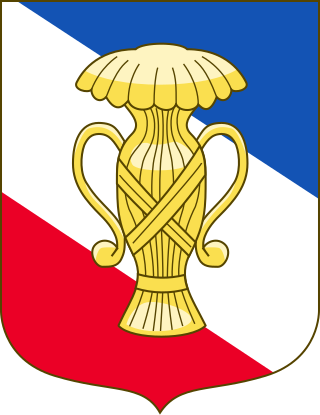
The House of Vasa or Wasa was an early modern royal house founded in 1523 in Sweden. Its members ruled the Kingdom of Sweden from 1523 to 1654 and the Polish–Lithuanian Commonwealth from 1587 to 1668; its agnatic line became extinct with the death of King John II Casimir of Poland in 1672.
The early Vasa era is a period in Swedish history that lasted between 1523–1611. It began with the reconquest of Stockholm by Gustav Vasa and his men from the Danes in 1523, which was triggered by the event known as the Stockholm Bloodbath in 1520, and then was followed up by Sweden's secession from the Kalmar Union, and continued with the reign of Gustav's sons Eric XIV, John III, John's son Sigismund, and finally Gustav's youngest son Charles IX. The era was followed by a period commonly referred to as the Swedish Empire, or Stormaktstiden in Swedish, which means "Era Of Great Power".
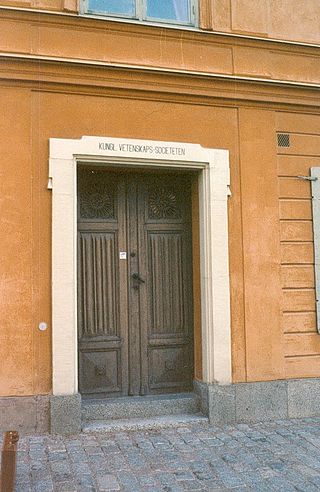
The Royal Society of Sciences in Uppsala, is the oldest of the royal academies in Sweden, having been founded in 1710. The society has, by royal decree of 1906, 50 Swedish fellows and 100 foreign.

The Archbishop of Uppsala has been the primate of Sweden in an unbroken succession since 1164, first during the Catholic era, and from the 1530s and onward under the Lutheran church.

Erik Benzelius was a Swedish theologian and Archbishop of Uppsala.

Erik Benzelius the younger was a priest, theologian, librarian, Bishop of Linköping, 1731–1742 and Archbishop of Uppsala, Sweden, 1742–1743. He was a highly learned man and one of Sweden's important Enlightenment figures.

Samuel Troilius was Archbishop of Uppsala from 1758 to his death.

Henrik Benzelius was Bishop of Lund from 1744 to 1747, and Archbishop of Uppsala in the Church of Sweden from 1747 to his death.

Jakob Benzelius was Archbishop of Uppsala in the Church of Sweden from 1744 to his death.

Laurentius Paulinus Gothus was a Swedish theologian, astronomer and Archbishop of Uppsala.
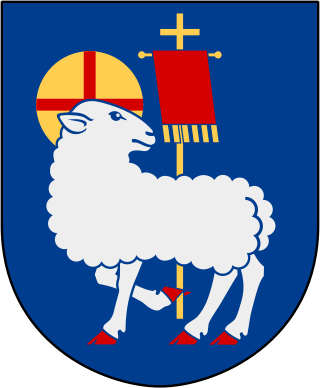
The Diocese of Västerås is a diocese within the Church of Sweden. Its Episcopal see is located in Västerås at Västerås Cathedral. The diocese was first established in the 12th century as part of the Roman Catholic church, but was made part of the Church of Sweden as a result of the Protestant Reformation in Sweden.

Saint Sigfrid of Sweden (Swedish: Sigfrid, Latin: Sigafridus, Old Norse: Sigurðr, Old English: Sigefrið/Sigeferð) was a missionary-bishop in Scandinavia during the first half of the 11th century. Originally from England, Saint Sigfrid is credited in late medieval king-lists and hagiography with performing the baptism of the first steadfastly Christian monarch of Sweden, Olof Skötkonung. He most likely arrived in Sweden soon after the year 1000 and conducted extensive missions in Götaland and Svealand. For some years after 1014, following his return to England, Sigfrid was based in Trondheim, Norway. However, his position there became untenable after the defeat of Olaf Haraldsson.
Ragnhild of Tälje is a saint whose veneration is attested in late medieval Sweden and whose name is especially associated with the church in Södertälje in the province of Södermanland and the diocese of Strängnäs. A year given for her death is 1117. According to mentions in various literature a few centuries later, she was also Queen of Sweden as the wife of King Inge the Younger. Some historians have introduced a possibility, refuted by others, that Ragnhild's father was Alstan, a son of Folke Filbyter, and that she thus belonged to the early House of Bjälbo of subsequent Swedish and Norwegian kings.
Joannes Olaus Alnander, (1694-1737), author of the History of Printing in Sweden, was born towards the end of the seventeenth century, at Norrköping. An analysis of this work is described in Acta Eruditorum Lipsiens. Supplem. viii. 506. Another work by him, published at Uppsala in 1721, is titled Notitiæ Litterariæ sectionis primæ pars III. exhibens res Judæorum, etc. Praes. E. Benzelius.

The Swedish Crown, also known as the "Purchased Crown", was a part of the Polish crown jewels.

Carl Jesper Benzelius was a Swedish theologian, professor, and bishop of the Diocese of Strängnäs from 1776 to 1793.
Benzelius is the surname of a Swedish family of pastors and theologians, which originated in Bensbyn in the municipality of Luleå, from which the surname was formed in Latin.
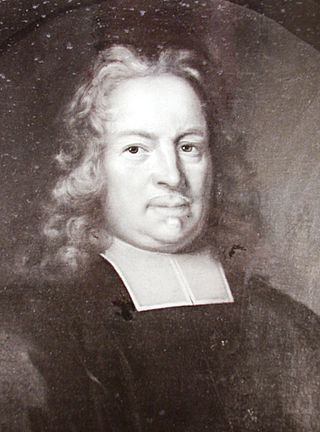
Johannes Bilberg was a Swedish theologian, professor and bishop. As a professor he was involved in the controversy over Cartesianism.
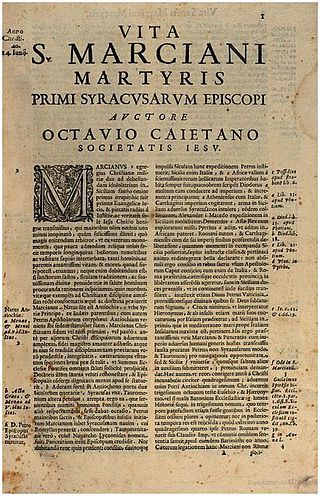
Ottavio Gaetani was an Italian Jesuit and historian, writing exclusively in Latin and most notable for his Vitae Sanctorum Siculorum. He is held to be the founder of hagiography in his native Sicily and one of the island's main 16th-century and early 17th-century historians.
Saint Brynoth of Skara was a medieval Swedish bishop who was canonized in 1498. His feast day is 9 May.
References
- ↑ This article is for the most part a translation of the unsigned article "Vastovius, Joannes" in Nordisk familjebok , 2nd ed., vol. 31 (1921), col. 804
- ↑ Vitis aqvilonia seu Vitae sanctorum qvi Scandinaviam magnam arctoi orbis peninsulam ac praesertim regna gothorum sveonumqae olim rebus gestis illustrarunt, opera et studio Ioannis Vastovii Gothi, Coloniae Agrippinae: Ant[onius] Hieratus, 1623. Entry in Libris
- ↑ Ioannis Vastovii, gothi, Vitis aquilonia, sive Vitae sanctorum regni sveo-gothici, emendavit et notis illustravit Ericus Benzelius filius. Upsaliae typis Johannis Henrici Werneri, typographi regii & academiae Upsalensis. MDCCVIII. Entry in Libris
- ↑ Natanael Beckman, review of Salomon Kraft, Textstudier till Birgittas revelationer (Uppsala 1929), in Scandia 3 (1930), p. 307. Beckman writes "ung och grumlig".(online scan)